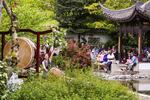A new tower — or two, or three — could be coming to Portland’s New Chinatown-Japantown historic district.
In an effort to spur development in the struggling commercial district, Portland City Council voted Thursday to give developers the option of building taller buildings there.
The vote divided the City Council, with Mayor Ted Wheeler, Commissioners Dan Saltzman and Chloe Eudaly arguing that development would give the neighborhood a much-needed boost, while Commissioner Amanda Fritz argued it would effectively destroy it.
“We need to infuse old town Japantown with activity. And there is none there now. We need people to live there,” Saltzman said.
Fritz appeared visibly shaken as she cast her vote and called it a sad day.
"I think this is a serious mistake that is going to repeat the mistakes that previous councils made in Albina, destroying a historic district and a cultural district," Fritz said.
Commissioner Nick Fish joined Fritz in voting against the proposal.
The council made the height changes in amendments it adopted to the 2035 Central City Plan, the city’s blueprint for new development downtown and in the city’s inner core.
The plan includes new height and design guidelines intended to preserve the character of the historic district, which is Oregon’s largest Chinatown.
The city’s current development plan, adopted in 1988, allows bona fide skyscrapers — up to 350 feet, or approximately 35 stories — in much of the new Chinatown-Japantown historic district.
Related: In East Portland, Trying To Build Community In A Planner's Nightmare
The council is set to have a final vote for the plan June 6.
The city’s planning and sustainability commission had recommended council reduce the allowed heights across the district in the 2035 plan to 125 feet or about 10 stories, to better match the existing historic buildings there, which top out at around seven stories.
The council had previously indicated it would set heights at 160 feet for much of the neighborhood.
But in Wednesday’s vote, the council voted to break from that standard and allow buildings up to 200 feet in two different places.
The first site, known as Block 33, is an empty parking lot between Fourth and Fifth avenues, not far from the historic Chinatown gate.
It belongs to developer Guardian Real Estate Services. The company plans to build an apartment tower and retail space.
The developer has pushed the council to allow for a taller building there, with the support of the Downtown Neighborhood Association.
“Development on Block 33 represents a potentially catalytic development site for our neighborhood,” the group wrote.
The council made the additional height a bonus that Guardian can earn in exchange for including affordable housing units in the building. Guardian will get an additional density bonus if all the development above the ground floor of the building is residential.
The council’s more controversial move was increasing the building heights allowed on four blocks that make up the northern half of the historic district, immediately adjacent to the city’s Lan Su Chinese Garden.

People watch Portland Taiko perform at Lan Su Chinese Garden to celebrate Asian-Pacific American Heritage Month in 2017. The garden had four performances each weekend throughout May from cultural groups representing a wide variety of Asian and Pacific nations.
Bradley W. Parks / OPB
A majority of the council voted to approve heights of up to 200 feet there — still a significant reduction from the 425 feet allowed in the 1988 plan. Saltzman introduced the amendment.
Lawyers for the Menashe family, which owns a portion of the blocks in question, had pushed for it, arguing it wasn’t fair for the council to award more height to the Lot 33 project than it was allowing in other parts of the neighborhood.
Community groups and the Old Town Neighborhood Association opposed the amendment, citing concerns about the impact to the garden.
Lan Su is one of just six classical Chinese gardens in North America. The garden's executive director, Lisa James, urged the council to vote against taller buildings, calling the garden more than just a tourist attraction.
“These walls of 200’ towers directly across the street to the West of the garden will undeniably have a detrimental effect on our long-term viability and that of our legitimate botanical collection,” James wrote.
But council members who favored the height increases said safeguards are in place to ensure that any new building won’t shade the garden.

Koi swim in a pond at the Lan Su Chinese Garden.
Bradley W. Parks / OPB
New developments in the historic district are required to conduct and comply with a shade study, among other requirements.
“I’m not buying many of these arguments,” said Commissioner Chloe Eudaly. “I have been assured by PBS staff that we can prevent any impact to the garden.”
Staffers say the shade study and other design requirements in the historic district make it unlikely 200-foot tall buildings will actually get built next to Lan Su.
“We’re not going to let shadows destroy the garden,” said Michel Cox, a spokesman for Wheeler.
